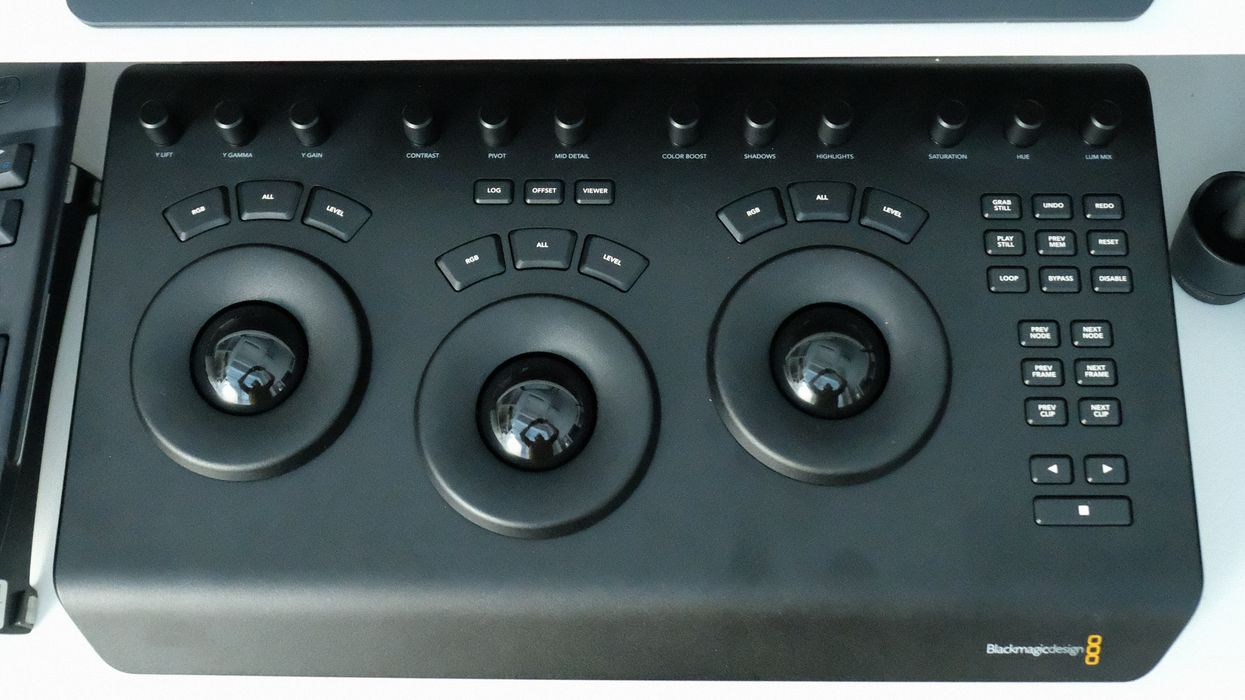REVIEW: Blackmagic Resolve Mini Panel Packs Renowned Quality into an Entry-Level Tool
Coming in at under $999, it's hard to believe how much thought and quality Blackmagic manages to pack in to their new entry-level color panel.

Introduction
Blackmagic Design has built a fantastic heritage but it has long had a hole in its platform. While Da Vinci Resolve owns the indie market for color and finish, and is moving hard at editing, the only color panels offered were the full-fledged $29,995 Advanced Panels. These are fantastic, but beyond the price point of any but the most dedicated colorist. In the age of the editor/colorist and on set grading, the Advanced panels often felt like a product from another time.
Finally, last month, Blackmagic filled out its line with the new Micro and Mini panels. The Micro is bare bones, focusing primarily on the track balls and a limited set of knobs and buttons, while the Mini is more sophisticated, with a set of LCD screens to help you navigate all the options available in the powerful Resolve software.
"This panel is clearly designed after long discussion and observation of real-life colorists and editors working in the field."

Overview
For $999, the Micro panel hits a price point that would have been hard to imagine a few years ago. While it currently competes with a single element panel for around $1500 and the Tangent Ripple for $300, neither of those panels come anywhere close to what is offered with the Resolve Micro panel.
Like all the competition, the Micro puts your main controls—shadow, midtone and highlight trackballs and wheels—front and center. It also has just the right knobs across the top, meaning the precise ones that you are looking for and will frequently use. With panels like the Tangent Wave, it often felt like one or two knobs were used 90% of the time and the rest were never touched; not so with the Micro. This panel is clearly designed after long discussion and observation of real-life colorists and editors working in the field. That expertise shows.

Blackmagic was nice enough to let us play with the full-sized Advanced panels before we tested the Mini, and while we are grateful to have spent time on the Advanced panels, having gone back and forth between them and the Mini with only a week's difference left us wondering why anyone would still consider the larger investment, outside of impressing a client. Yes, the buttons on the Advanced panel do feel ever so slightly more pleasant to punch. Their mechanical click is satisfying. And the backlighting is beautiful. But the goal on these types of tools is to never need the backlighting, to memorize key positions so you never need took down, you can keep your eyes on your image, and lose yourself in the grade. The Advanced panels are the ultimate tool for that, but the Micro panel gets you pretty damn close.

The quality of the feel and accuracy of the Mini panel matched the Advanced panel almost perfectly. Yes, having a dedicated button for every possible function is very nice, and can speed up your workflow. And yes, the Advanced panels are physically large and quite impressive. But the combination of a Micro or a Mini with the right keyboard or keyboards with shortcuts provide 97% of the functionality of the full panels, making it very hard to justify the cost for even well-financed facilities to purchase new Advanced panels when they could instead buy 30 Micro panels, or 10 Mini panels. The willingness of Blackmagic to cannibalize their own Advanced panels business by coming up with these smaller panels is impressive.

As fewer and fewer sessions happen with clients in the room, and color gets spread out more and more between set, the edit suite, and the finishing suite, expect to see even high-end productions wrapping their grade on a Mini or Micro panel.
Build quality
Fantastic. There are very few times in a review where we can say “heavy” as a good thing, but it feels “heavy,” and that is a good thing. It’s going to sit down on your desk exactly where you put it, and not scoot around. It’s going to survive 40 hour weeks, week after week, coloring beautiful work and earning you a living. When your hands reach down to a panel, they’ll find the trackball exactly where it’s supposed to be without thinking.

Surprisingly, for a unit so physically heavy and substantial feeling, it works entirely over USB-C, and ships with a cable to patch into your older USB connection if you don’t have a 2016 Macbook Pro. It feels like they packed every single feature they could into the panels that could be powered over that tiny cable, then put everything else into the Mini panel, which requires separate power. Using this with a Macbook Pro, with Mini Monitor for viewing (and only the computer and the monitor plugged in) felt positively reckless. Imagine only two plugs for a full-fledged color grading setup.
"This panel is the absolute, hands down best choice for the part-time colorist, freelancer, or production company that grades once a month or once a week."
Ergonomics
“Wheel around the ball” is just better than “wheel above the ball.” The wheels, the balls, and the knobs also just feel right: smooth, precise, no slip, just the right amount of sensitivity to make tiny adjustments but not set to be so sensitive that it takes a million years to make an extreme correction. You can leave your index finger on the ball and move the wheel with your ring finger and make subtle tweaks and adjustments to find that perfect sweet spot in the image without ever looking down, then reach up to the Color Boost knob and tweak just slightly without going too far.

Fulfilling specific purpose
This panel is the absolute, hands-down best choice for the part-time colorist, the freelancer, or the production company that grades once a month or once a week. If you work in Resolve, there is no reason to consider anything else. This is it. If you grade every day, the Mini is probably worth the upgrade over the Micro, but only maybe. For its specific purpose, it can’t be beaten.
Nothing good comes without cost, however, and this panel does have one limitation. Being a Blackmagic product, it currently only works with DaVinci Resolve. Now, Blackmagic also makes the DNxIO, which works with Avid and Premiere and Final Cut, even though they make Resolve, which is a competitive editor, so it’s possible this panel might support other platforms in the future. Most Blackmagic products work with a wide array of platforms. Having this work with Pomfort LiveGrade, or even Premiere, is unlikely but it would be nice.
Unexpected usefulness
One bonus of the Micro panel is that it works well with the Kenesis Pro keyboard.

With smaller panels, colorists frequently have to use their keyboard to extend their functionality, using shortcuts for commonly used features that didn’t make it to the panel mapping. The Kinesis lets you put the trackballs front and center, with half of the keyboard on either side, and has worked well for many colorists for both the ripple and element panels.

As you can see, the Micro panel slips perfectly in between the two sides of the Kinesis. The height even lines up well. It’s kind of perfect.
"Small" complaint
“Micro” and “Mini” feel like the wrong names for these panels. They fit in the naming convention from the Blackmagic camera line, but the “micro” panel still dwarfs the Tangent Ripple.

Conclusion
Do you work in Resolve? If so, and you were thinking of a panel, $999 for the Micro is the best value for money in the film world today. You are likely to get years and years and years out of these panels.
TL:DR
- Unbelievable value for price
- Works with a great keyboard for extra shortcuts
- Substantial, highly functional panel, with precise color control and pleasantly spinning wheels
- Full power and function over a single USB cable
- Only drawback is application support, unlikely to change, but a filmmaker can dream











